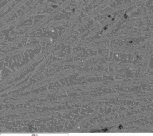Gerry McDonnell
Archaeometallurgy
Hofstaðir Slag Analysis.
|
|
Smelting Tap Slag |
Smelting Flowed Slag |
Smithing Slag |
Lava |
|
Na2O |
0.7 |
0.4 |
1.0 |
2.7 |
|
MgO |
2.8 |
2.6 |
3.3 |
5.95 |
|
Al2O3 |
7.9 |
4.0 |
7.5 |
20.45 |
|
SiO2 |
32.1 |
20.5 |
33.3 |
46.15 |
|
P2O5 |
1.7 |
1.1 |
1.7 |
0.4 |
|
SO3 |
0.2 |
0.1 |
0.2 |
n.d |
|
K2O |
2.3 |
1.4 |
2.1 |
0.7 |
|
CaO |
8.5 |
5.6 |
8.3 |
12.1 |
|
TiO2 |
0.6 |
0.4 |
0.9 |
2.35 |
|
V2O5 |
0.2 |
0.1 |
0.2 |
0.2 |
|
Cr2O3 |
n.d |
n.d |
0.1 |
0.25 |
|
MnO |
1.5 |
1.0 |
1.3 |
0.15 |
|
FeO |
41.3 |
62.6 |
40.1 |
8.75 |
|
CoO |
0.2 |
0.3 |
0.1 |
n.d |
|
NiO |
0.1 |
0.1 |
0.2 |
n.d |
|
CuO |
n.d |
n.d |
0.1 |
0.2 |
|
BaO |
0.1 |
n.d |
0.2 |
n.d |
Three main morphological types of slag were recognised on the site. Smelting Tap Slag, Flowed Slag and Smithing Slag. The bulk area analyses (SEM Data) show no clear distinction between the three slag types. The similar levels of mnO in the three slag types is challenging, as lower levels would be expected in the smithing slag.The lava although displaying similar features e.g. to the flowed slag is significantly lower in iron oxide.

SEM BSE Image of tap slag sample. Source: Author







